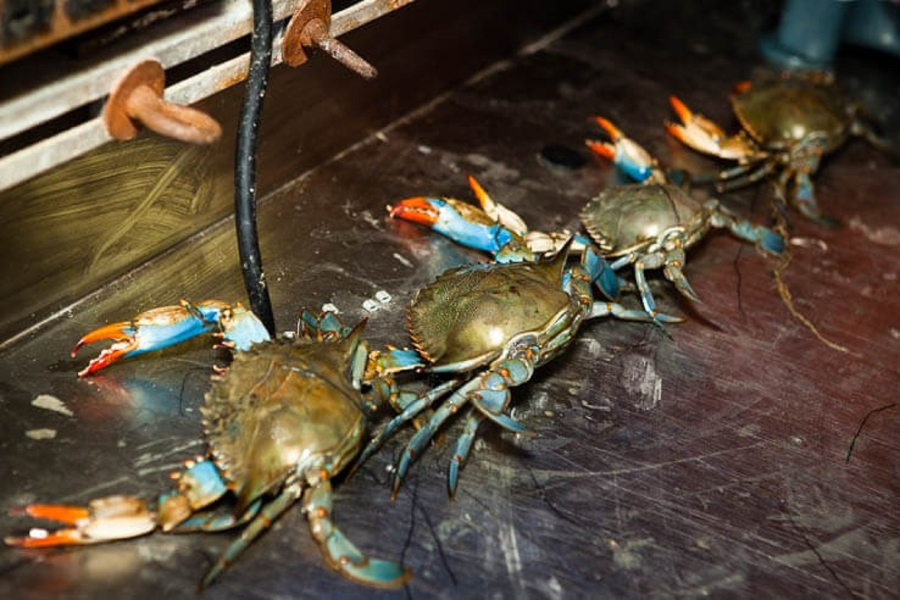Blue crab population increases by 60%, stock considered sustainable
Experts recommend a cautious, risk-averse approach to resource management

The 2019 Blue Crab Advisory Report finds the overall Chesapeake Bay blue crab population to be not depleted or overfished. Additionally, the most recent winter blue crab dredge survey estimated that the Chesapeake Bay is home to 594 million blue crabs, a 60% increase over last year.
Results of the survey, conducted by the Maryland Department of Natural Resources and the Virginia Institute of Marine Sciences, show that the Bay’s total adult female blue crab population has increased nearly 30% to 191 million. This is well above the abundance threshold of 70 million crabs and near the target of 215 million crabs.
Experts assess the sustainability of the blue crab stock by comparing the percentage of the female blue crab population harvested each year to a 25.5% target and a 34% overfishing threshold. Because the latest female harvest levels are below both of these “reference points,” the blue crab population is not considered depleted, nor is it being overfished.
The juvenile blue crab population—crabs that will grow to be a harvestable size this fall—increased to 322 million, which is above the long-term average of 224 million. Due to the warmer weather this past winter, the percent of crabs that died in between the fall and spring was lower than usual at 1.8% compared to 6.37% last winter.
The Chesapeake Bay Stock Assessment Committee (CBSAC) develops the annual Blue Crab Advisory Report by evaluating both the winter dredge survey and harvest data to develop advice for fisheries managers. As part of the Chesapeake Bay Program, CBSAC—which includes representatives from state agencies, academic institutions and federal fisheries experts—supports the Sustainable Fisheries Goal Implementation Team.
An estimated 55 million pounds of blue crabs were commercially harvested from the Chesapeake Bay last year, which is below the 1990-2018 averages. Commercial and recreational crabbers harvested 23% of the female blue crab population in 2018.
CBSAC recommends that Maryland, Virginia and the Potomac River Fisheries Commission maintain a cautious, risk-averse approach to blue crab management, put procedures in place to provide accurate accountability for all commercial and recreational harvests and explore new reporting technologies.
“By using sound science included in this annual report to manage the fishery, the Bay jurisdictions have enabled responsible harvest of female blue crabs for the past 10 consecutive years,” said Sean Corson, chair of the Chesapeake Bay Program’s Sustainable Fisheries Goal Implementation Team, in a media release. “Consumers can enjoy their Chesapeake Bay crab feasts knowing blue crabs are responsibly managed.”

Comments
The size of blue crabs is largely driven by water temperature. Increased carbon pollution and warming waters actually cause a blue crab’s shell to grow abnormally large, but there tends to be less meat underneath. Larger blue crabs are not necessarily a good thing, as it indicates climate change impacts to the ecosystem around them. A study from the University of North Carolina found that blue crabs will “supersize their growth” in the next 75 to 100 years due to carbon pollution (source: https://www.washingtonpost.com/national/health-science/2013/04/07/a0c29f48-972f-11e2-b68f-dc5c4b47e519_story.html?_=ddid-3-1564594440). Warming waters may lead to larger blue crabs, but that also means a disruption to the entire ecosystem (source: https://www.washingtonpost.com/climate-environment/2019/07/31/climate-change-will-spark-blue-crab-baby-boom-then-predators-will-relocate-south-eat-them/).
Why are the Blue crabs so much larger in general in the Chesapeake than the GSB?
Since the Bay is such a shallow estuary, any little change can impact plant and animal species. Since we’ve been having a drier summer, the increased salinity from less fresh water entering the Bay, and potentially warmer water temperatures, can lead the crabs to seek out different regions of the Bay that are more comfortable to them.
Hi ..happy cr@bbing. I’m crabbing in va , ocean view, Norfolk. The crabs were plentiful two weeks ago. They are all but gone now. Do you know wha5 happened ?
Thx
Dor .
The 2019 Blue Crab Advisory Report is released each year by the Chesapeake Bay Program and is informed by the results from the winter dredge survey (winter 2019), conducted by the Maryland Department of Natural Resources and the Virginia Institute of Marine Sciences, and harvest data from the previous year (2018). Essentially, the winter dredge survey is an estimate of the blue crabs living in the Bay, but it uses a stratified random design to calculate its findings. For detailed information on how the survey is conducted, please visit: https://dnr.maryland.gov/fisheries/Pages/blue-crab/dredge.aspx and https://www.vims.edu/research/units/programs/bc_winter_dredge/index.php. Commercial harvest numbers are reported to the respective state agencies each year.
While this number is significantly higher than last year, it is not considered to be an explosion of crabs. The winter dredge survey has estimated as many as over 800 million crabs in the Bay in the early 1990s. Historical data can be viewed here: https://www.chesapeakebay.net/state/blue_crabs.
While this sounds like wonderful news, I’d like to know more about how the data is gathered. It sounds like a lot of assumptions to me. And if it is true I’d like to know more about the impact the crab explosion has on the rest of the marine ecosystems.
Thank you!
Your comment has been received. Before it can be published, the comment will be reviewed by our team to ensure it adheres with our rules of engagement.
Back to recent stories